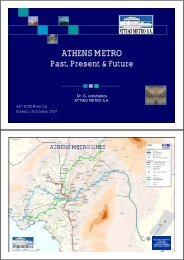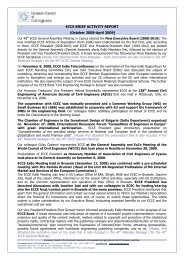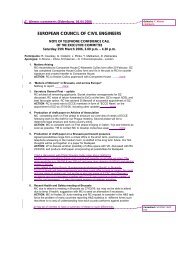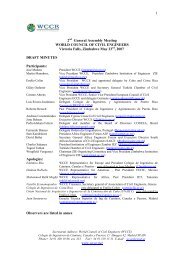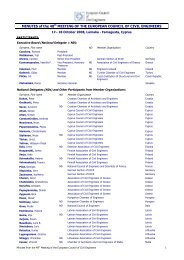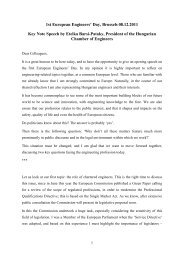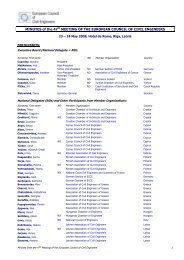A Closer Look at Prevailing Civil Engineering Practice - European ...
A Closer Look at Prevailing Civil Engineering Practice - European ...
A Closer Look at Prevailing Civil Engineering Practice - European ...
You also want an ePaper? Increase the reach of your titles
YUMPU automatically turns print PDFs into web optimized ePapers that Google loves.
A <strong>Closer</strong> <strong>Look</strong> <strong>at</strong> <strong>Prevailing</strong> <strong>Civil</strong> <strong>Engineering</strong> <strong>Practice</strong>, Wh<strong>at</strong>, Why and How<br />
Vincent T. H. CHU<br />
3. When would engineers use Cone Penetr<strong>at</strong>ion Testing instead of<br />
Standard Penetr<strong>at</strong>ion Test<br />
(I) Standard Penetr<strong>at</strong>ion Test is carried out in boreholes <strong>at</strong> 1.5-2m intervals.<br />
However, Cone Penetr<strong>at</strong>ion Testing allows a continuous record of<br />
ground resistance profile.<br />
(II) Disturbance to ground is less by Cone Penetr<strong>at</strong>ion Testing when<br />
compared with Standard Penetr<strong>at</strong>ion Test.<br />
(III) The use of Cone Penetr<strong>at</strong>ion Testing is faster and cheaper when<br />
compared with the combin<strong>at</strong>ion of boring, sampling and Standard<br />
Penetr<strong>at</strong>ion Test.<br />
4. How to identify sand and clay from the results of Cone Penetr<strong>at</strong>ion<br />
Testing<br />
Cone Penetr<strong>at</strong>ion Testing measures the pressure <strong>at</strong> the end of cone (end<br />
resistance), friction on sleeve and pore w<strong>at</strong>er pressure. Friction r<strong>at</strong>io is<br />
defined as the r<strong>at</strong>io of friction/end resistance.<br />
For clay, typical CPT results exhibit low end resistance, high friction r<strong>at</strong>io<br />
and high pore w<strong>at</strong>er pressure.<br />
For sand, typical CPT results exhibit high end resistance, low friction r<strong>at</strong>io<br />
and low pore w<strong>at</strong>er pressure.<br />
5. Wh<strong>at</strong> is the purpose of adding hydrogen peroxide in sediment<strong>at</strong>ion<br />
analysis<br />
There are two major techniques of particle size distribution:<br />
(i) Sieve analysis – for soil particles larger than 60µm they can be<br />
separ<strong>at</strong>ed by this method.<br />
(ii) Sediment<strong>at</strong>ion analysis – for soil particles smaller than 60µm, they<br />
are too small to be sieved by sieve analysis. Instead, the particle<br />
size distribution is worked out from the r<strong>at</strong>e of settlement of soil<br />
particles suspended in w<strong>at</strong>er by Stoke’s law.<br />
In sediment<strong>at</strong>ion analysis, the soil under testing is firstly boiled with little<br />
distilled w<strong>at</strong>er to wet and break up the particles. After th<strong>at</strong>, hydrogen<br />
peroxide is added to remove any organic m<strong>at</strong>erial. Then the whole mixture<br />
is allowed to stand still for a night and then boiled again to remove<br />
hydrogen peroxide.<br />
67






